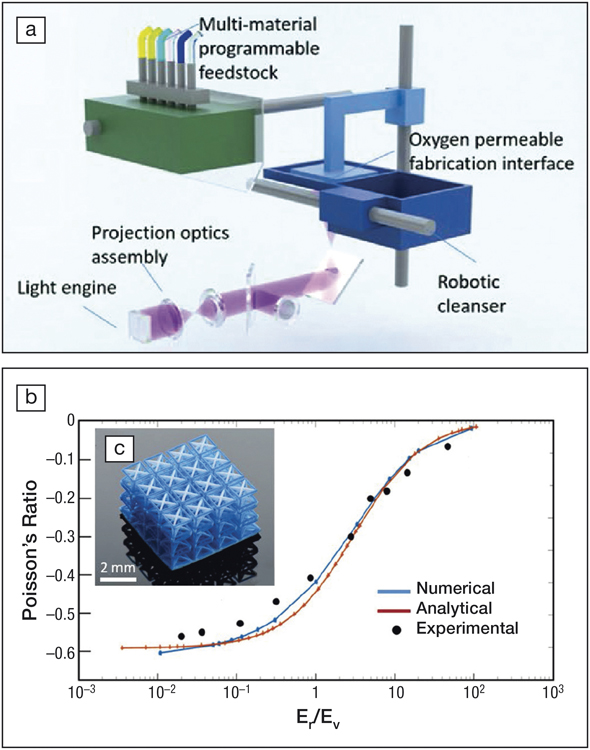Three-dimensional (3D) printing technology has transformed the way we conceive materials as it allows for bottom-up fabrication of customized designs and 3D shapes. However, 3D printing is generally limited to the printing of a single material composition. Being able to spatially vary the materials composition and mechanical properties along with the 3D architecture would be a major step forward to harness unusual behaviors such as enhanced ductility or fracture toughness, zero or negative thermal expansion, or to achieve biomimetic structures. Ductility, for example, can be amplified by building gradients from soft to hard components, which is observed in bone-tendon or bone-ligament connective tissues.
But forming 3D printed materials with dissimilar compositions and mechanical properties is challenging. The interfaces need to be tight enough to prevent unbinding, while remaining sharp enough to avoid blending of the two materials and homogenization. In an article published recently in Scientific Reports (doi:10.1038/s41598-018-26980-7), Xiaoyu (Rayne) Zheng and his student Da Chen from Virginia Tech introduced an additive manufacturing method where 3D porous architectures can have spatially varying mechanical properties.
The reported additive manufacturing tool is a 3D printer with multiple extrusion nozzles that deposit struts onto a transparent window (Figure a). The struts are blends of acrylate monomers mixed at various ratios to offer low or high stiffness. After each layer is deposited, the structure is strengthened by UV-curing using UV light placed below the transparent window. To change the chemical composition without cross-contamination between the inks, a robotic device cleans the printing tip quickly and efficiently. This novel addition is unique in 3D printing systems and is pending an international patent. Exploiting the full capabilities of traditional 3D printing, the researchers printed porous microlattices of 1–2 cm, with a strut diameter of ca. 100 µm and with different geometries.
One major interest of Zheng’s research group is in “morphing structures for lightweight flight structure designs, bioinspired morphing materials, flexible body armor with enhanced energy absorption, and fracture resistance, as well as active materials.” Therefore, building microlattices enables lightweighting due to the high porosity, whereas control of the local mechanical stiffness and microarchitecture can enable uncommon properties. An example discussed in the article is auxetic structures with negative Poisson’s ratio—when the structure is stretched, the width can extend up to seven times! This nonlinear deformation results from amplification through the struts’ design in shape, angle, and Young’s modulus. Analytical and numerical calculations of the strains experienced by these structures were validated by experiments. With the polymeric blends used in this study, the Poisson’s ratio can be varied from –0.7 to 0 (Figure b, c).
Victoria Garcia Rocha, a lecturer at Cardiff University, UK, has also developed a multi-material 3D printing strategy using graphene-based inks, but for electrochemical energy-storage. She explains that “the capability of changing the local stiffness and metamaterial design can also have a huge impact in 3D printing of energy-storage devices. The outcomes of the paper can be applied in order to understand or re-design multi-material electrodes, which are inherently very different like metals, carbon, and ceramics, but also usually assembled in packaging to avoid electrolyte losses.” She is very curious to see if the concept of changing the stiffness of the polymer can be applied for materials of a different nature like those just cited. Rocha also explains that “the ability of avoiding cross-contamination when printing photo-curable polymers is a huge advance in 3D printing. Also, it is highly relevant to have a chemistry processing that allows good interfaces when varying the materials composition. By using robocasting, for example, the ink can by varied via a multi-syringe printer head. This gives large versatility in the chemistry, but more efforts are needed to have good interfaces and to avoid post-processing.”

(a) Schematic of the multi-material 3D printing apparatus. (b) Variation of the Poisson’s ratio in function of the ratio Er/Ev, which is the ratio between the Young’s modulus of two orthogonal phases in the lattice presented in the inset (c). Credit: Scientific Reports.
“As long as [the polymers] are curable under UV light, there is the potential to be assembled into the fabrication system and metamaterials,” Zheng says. His team will now explore how to extend this technology to complex materials systems with controlled deformations and multifunctionalities that transcend structural properties.


